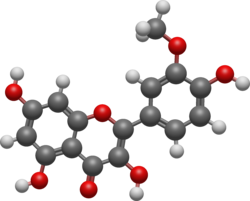 | |
 | |
| Names | |
|---|---|
| IUPAC name 3,4′,5,7-Tetrahydroxy-3′-methoxyflavone | |
| Systematic IUPAC name 3,5,7-Trihydroxy-2-(4-hydroxy-3-methoxyphenyl)-4H-1-benzopyran-4-one | |
| Other names 3-methylquercetin 3-Methylquercetin Isorhamnetol isorhamentin isorhamnetine iso-rhamnetin 3'-Methoxyquercetin | |
| Identifiers | |
3D model (JSmol) | |
| ChEBI | |
| ChEMBL | |
| ChemSpider | |
| ECHA InfoCard | 100.006.860 |
| KEGG | |
PubChem CID | |
| UNII | |
CompTox Dashboard (EPA) | |
| |
| |
| Properties | |
| C16H12O7 | |
| Molar mass | 316.26 g/mol |
| Melting point | 307 °C (585 °F; 580 K) |
Except where otherwise noted, data are given for materials in their standard state (at 25 °C [77 °F], 100 kPa). | |
Isorhamnetin is an O-methylated flavon-ol from the class of flavonoids. A common food source of this 3'-methoxylated derivative of quercetin and its glucoside conjugates are pungent yellow or red onions, in which it is a minor pigment, quercetin-3,4'-diglucoside and quercetin-4'-glucoside and the aglycone quercetin being the major pigments. [1] Pears, olive oil, wine and tomato sauce are rich in isorhamnetin. [2] Almond skin is a rich source of isorhamnetin-3-O-rutinoside and isorhamnetin-3-O-glucoside, in some cultivars they comprise 75% of the polyphenol content, the total of which can exceed 10 mg/100 gram almond. [3] Others sources include the spice, herbal medicinal [4] and psychoactive Mexican tarragon (Tagetes lucida), which is described as accumulating isorhamnetin and its 7-O-glucoside derivate. [5] Nopal (Opuntia ficus-indica (L.)) is also a good source of isorhamnetin, which can be extracted by supercritical fluid extraction assisted by enzymes. [6]